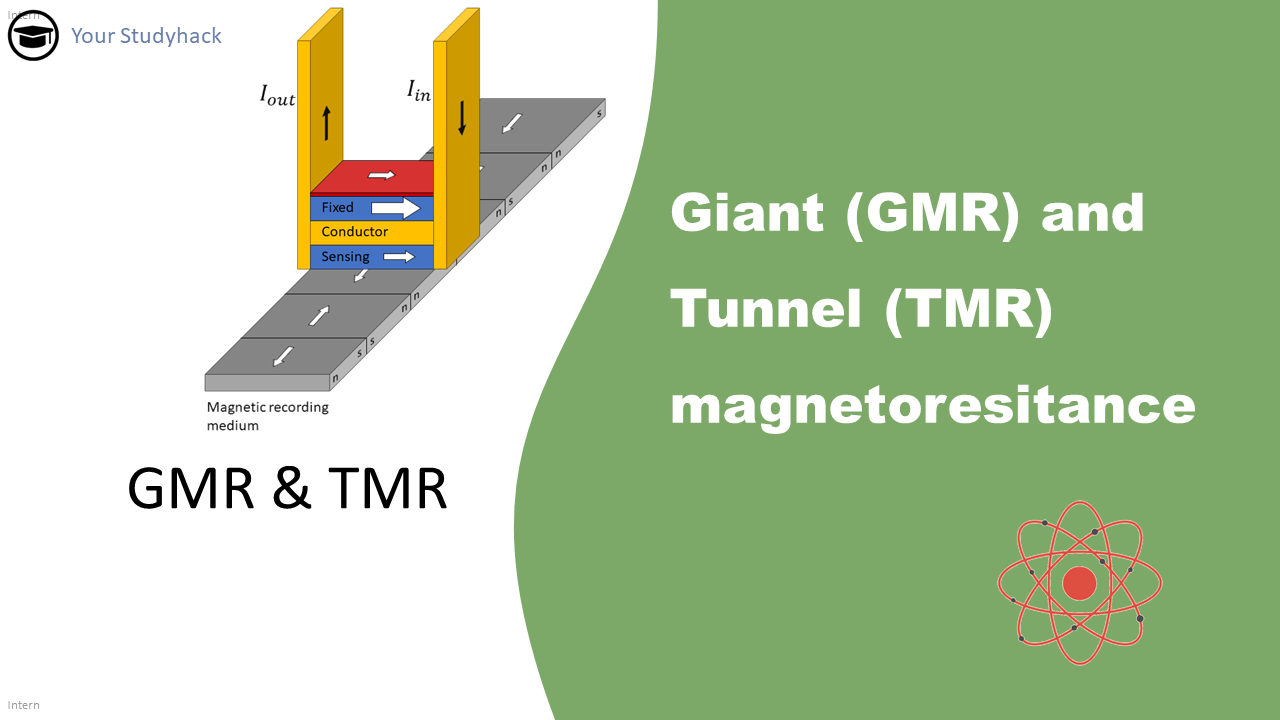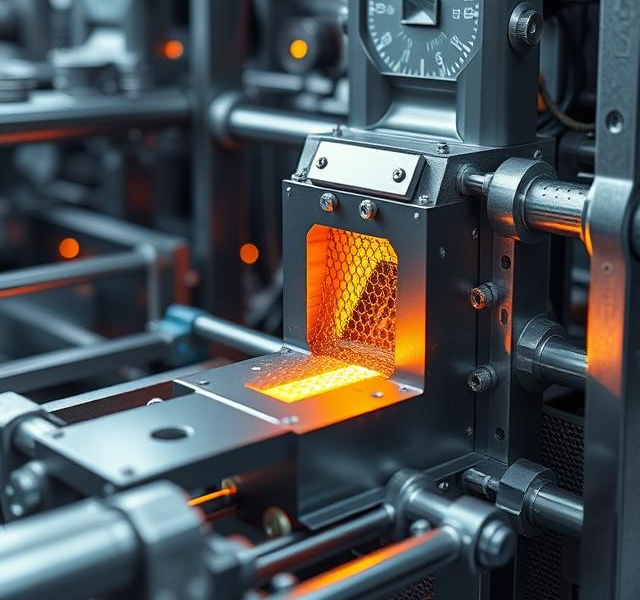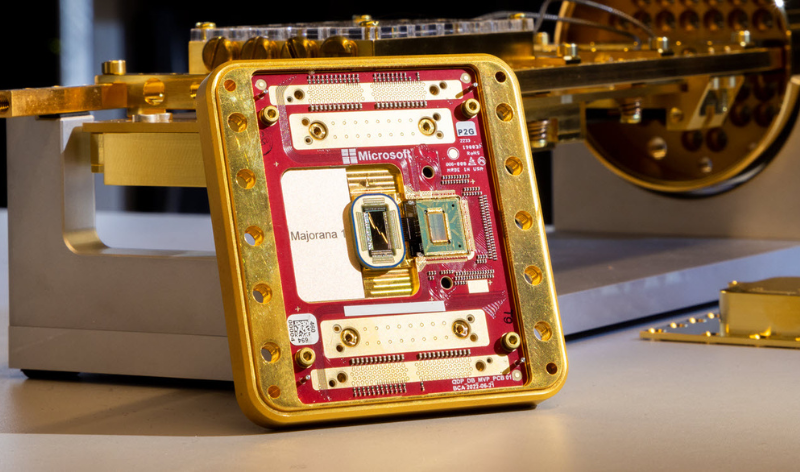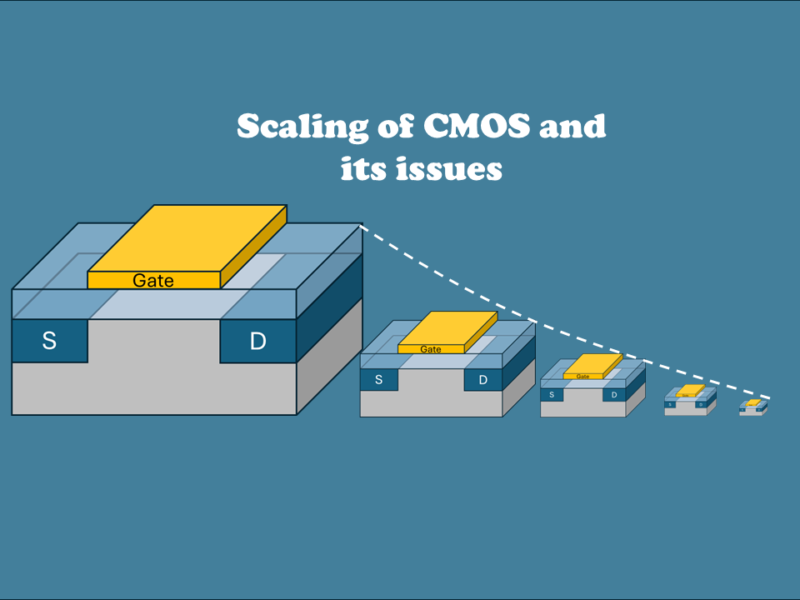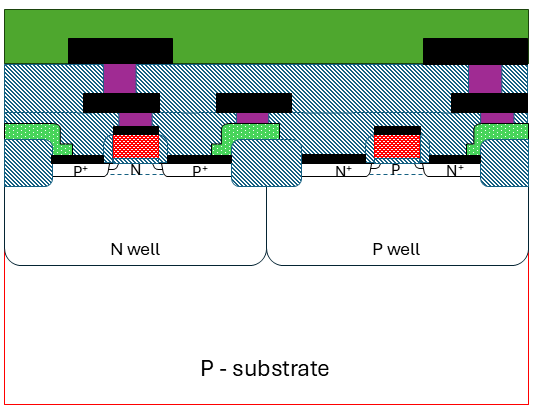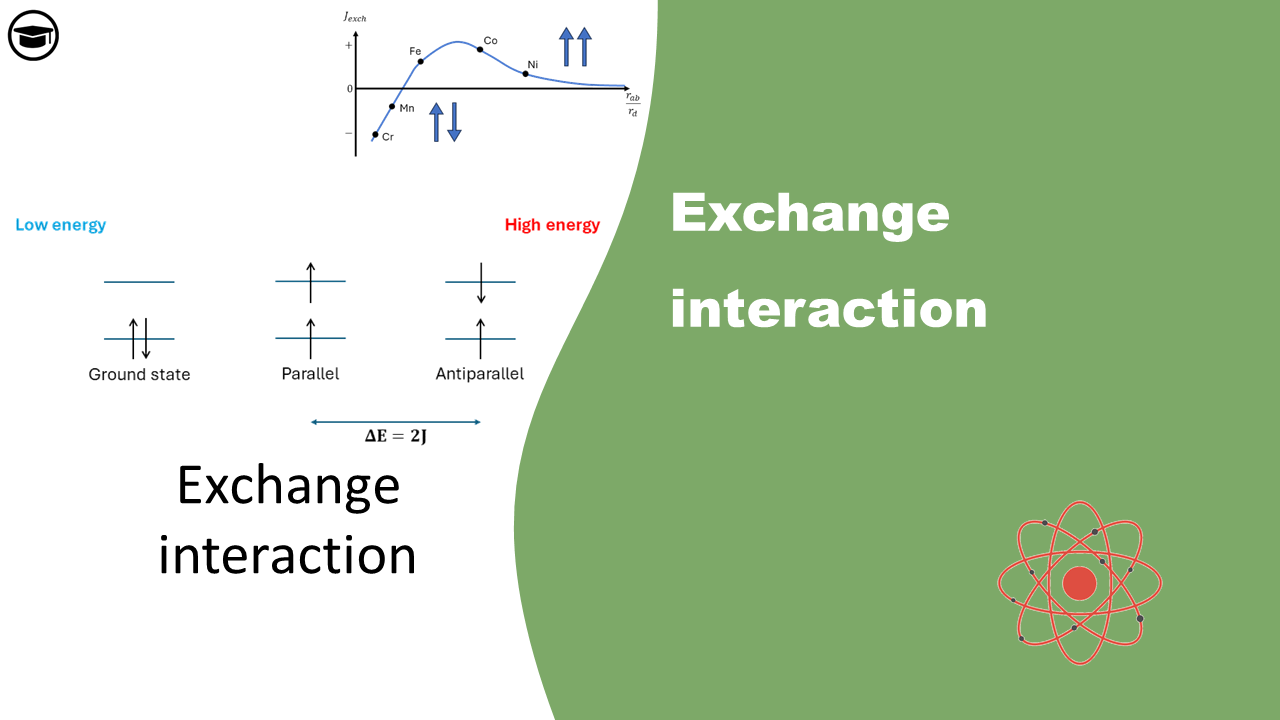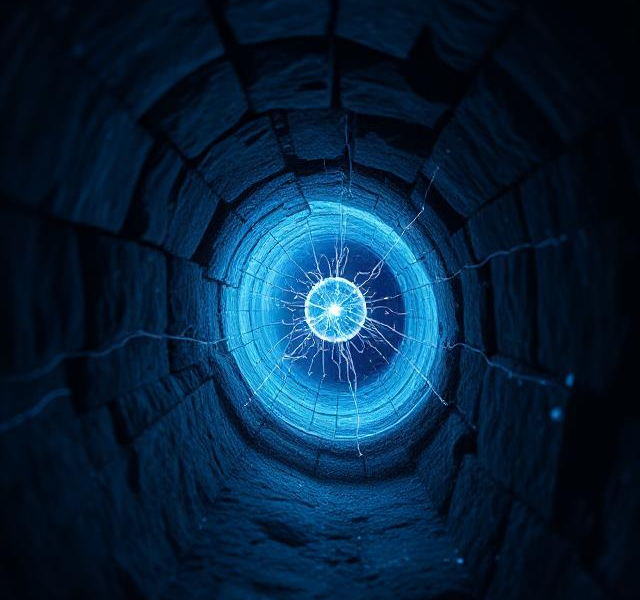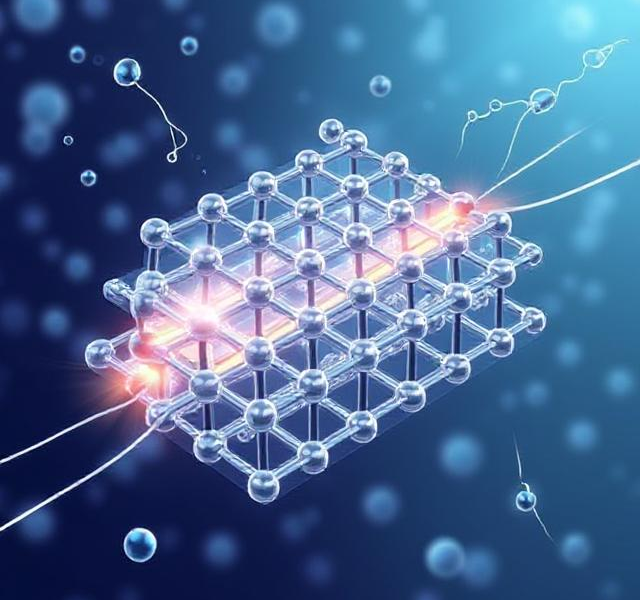Giant magnetoresistance (and later Tunnel magnetoresistance) is one of the biggest discoveries in thin-film magnetism. Within 10 years after its discovery, it was already used in commercial devices, such as hard disk drive read heads, changing the world. Just like other magnetoresistive effects, GMR is about the change in resistivity as a result of an applied magnetic field on it. For this reason, we will talk in this post about ΔR/R as a measure of how much the resistance changes under such effect. In the first section, I will mainly talk about spin polarized transport, and how metallic freromagnets can conduct electricity. From there we take a jump to GMR, explain how it works, and one of its applications. Lastly we also take a look at another important structure in spintronics, the magnetic tunnel junction, where the layer between the ferromagnets is an insulator, and the only way an electron can cross this is by quantum tunneling.
1. Spin polarized transport
[latexpage] Magnetoresistance is the property of a material to alter its electrical resistance when subjected to an external magnetic field. This phenomenon was initially observed by William Thomson (Lord Kelvin) in 1857 [12]. When he introduced a metal with a current flowing through it to a magnetic field, either perpendicular or parallel to the direction of the current, he noted a marginal change in its bulk resistance, typically less than ΔR/R < 5%.
The use of spin-polarized currents opens up significantly more intriguing applications in magnetoresistance. Spin-polarized transport naturally occurs in materials where there exists an imbalance in the spin population at the Fermi level. This imbalance is commonly found in ferromagnetic metals, where the density of states (DOS) available to spin-up and spin-down electrons is nearly identical, albeit with a disparity in energy levels.
1.1 The Mott model
![Fig 1. A schematic of the density states in normal- and ferromagnetic metals. E is the electron energy; EF is the Fermi energy level; Z(E) is density of states. Image based on [1].](https://florisera.com/wp-content/uploads/2024/04/Slide1-768x441.png)
In the Mott model it is proposed that the electrical conductivity in metals can be described in terms of two largely independent conducting channels, corresponding to the spin-up (↑) and spin-down ↓) electrons. Electrical conduction occurs in parallel across these two channels [13].
In non-magnetic conductors, the scattering remains invariant with respect to the electron spin. However, in ferromagnetic metals, the scattering rates of the spin-up and spin-down electrons are different. Typically, it is presumed that the scattering is strong for electrons with spins anti-parallel to the magnetization direction and weak for electrons with spin parallel to the magnetization direction. This translates into different resistivity for spin-up and spin-down electrons, dependent on the magnetization of the material.
Ferromagnetic materials have a majority of electrons in one spin state (typically the up-state by convention). Figure 1 shows the density of states Z(E) as a function of energy E for normal and ferromagnetic materials. This schematic diagram illustrates that in ferromagnetic material (on the right), the available majority spin states (up-state) are fully occupied at the Fermi level, whereas this is not the case for the minority spin states (down-state). This phenomenon directly arises from the spin imbalance induced by Hund’s rule.
1.2 Band structure of magnetic materials
![Fig 2. A schematic of the density states in ferromagnetic metals. E is the electron energy; Z(E) is density of states; and EF is the Fermi energy level for the materials Iron, Cobalt and Nickel; [2]](https://florisera.com/wp-content/uploads/2024/04/Slide2.png)
![Fig 3. Electronic band structures (left panels) and the density of states (right panels) of Cu (a) and fcc Co for the majority spin (b) and minority spin (c) electrons. Image taken from [3].](https://florisera.com/wp-content/uploads/2024/04/DOS-and-band-structure.png)
In general, in ferromagnetic materials, there is an asymmetry near the Fermi level, with the density of states being greater for spin-down compared to spin-up. Notably, for Ni, Co and Fe, these differences can be observed in the 3d orbitals [2]. Among these materials, distinctions exist; for instance, examining the actual density of states for Fe reveals that although both spin-up and spin-down states are present, one vastly outweighs the other. Conversely, for Co, the scenario presents a different variation, with no more spin-up states available, as is illustrated in Figure 2.
Figure 3 (a) shows the band structure of non-magnetic Cu on the left panel, and the density of states on the right panel, the latter is the same for spin-up and spin-down electrons. It is characterized by the fully occupied d bands and the presence of a dispersive sp band at the Fermi energy level, which result in high conductivity of Cu. The electronic structure of ferromagnetic Co is different for the two spin orientations and is characterized by the exchange-split d bands. The Fermi level lies within the sp band for the majority-spin electrons (b), which leads to high conductivity of majority-spin channel. The Fermi level lies, however, within the d band for the minority-spin electrons resulting in low conductivity of the minority-spin channel (c). In the latter case the $sp$ electrons are strongly hybridized with the d electrons, which diminishes their contribution to conduction [3].
1.3 Spin dependent transport in the diffusion limit
The following section goes further into the conceptual idea, rather then rigorous scientific principles. Fermi’s “golden rule” basically states that the scattering probability of an electron depends on the availability of final states for scattering [14]. Consequently, electrons with spin-up and spin-down orientations exhibit different resistivities, because of the difference in available states to scatter to.
![Fig 4. The difference in diffusion length and mean free path of an electron [4].](https://florisera.com/wp-content/uploads/2024/04/Slide5.png)
The idea of this model is based on the presumption that spin-flip scattering events are much less likely than regular scattering events (see Figure 4), the spin diffusion length is normally much larger than the mean free path of the electrons [4]. With this in mind, we can use the “two channel” conduction model (see Figure 5) to explain the resistance in metallic ferromagnets. Thus, in ferromagnetic metals the scattering, and as a consequence also the resistance, depends on the spin of the electron.
![Fig 5. Two channels conduction model [4].](https://florisera.com/wp-content/uploads/2024/04/Slide4-768x231.png)
The ability to manipulate spin within metallic structures presents an intriguing way for controlling resistivity. Figure 6 basic configuration involves two magnetic materials separated by a metallic layer, with a current flowing perpendicular to the plane (CPP). When both ferromagnets (left and right) exhibit identical spin orientations, electrons encounter many available states to traverse from the first ferromagnet through the metal and onto the second ferromagnet, resulting in low resistance. Conversely, for the opposite scenario, while electrons can easily transition from the first ferromagnet to the metal; the absence of available states in the second ferromagnet with the correct spin spin orientation lowers the chance of electron transmission, thereby giving higher resistance [16]. However, CPP devices are generally not fabricated in this way.
![Fig 6. Spin polarized devices in the CPP geometry. These deviices are generally not fabricated in this way [16].](https://florisera.com/wp-content/uploads/2024/04/1.png)
2. Giant Magnetoresistance (GMR)
A much more interesting structure makes use of the giant magnetoresistance (GMR) effect in thin magnetic multilayers. This has less to do with the density of states, but more with the scattering mechanism. It was first discovered by Fert et al.[5] that applying a magnetic field to a Fe/Cr multilayer resulted in a reduction of the resistance of the multilayer, with ΔR/R ≈ 50%. The effect was much larger then the ordinary magnetoresistance, and for that reason it was called the “giant magnetoresistance”. Figure 7 shows the drop in resistance for different sets of layer thicknesses as a function of applied magnetic field. Around the same time, a similar discovery was made in Fe/Cr/Fe trilayers by another group under supervision of P. Grunberg [15], albeit with smaller change differences. Due to the importance of these discoveries, both A. Fert and P. Grünberg received the Nobel prize in physics in 2007 (see Figure 8) [6].
![Fig 7. he results from Fert’s original paper. The current and the applied magnetic field are along the same axis in the plane of the layers [5].](https://florisera.com/wp-content/uploads/2024/04/GMR-resistance-change.png)
![Fig 8. GMR discovered simultaneously by Fert et al. (Orsay) and Grünberg et al. (Jülich [6].](https://florisera.com/wp-content/uploads/2024/04/Fert-Grunberg.png)
By making very thin layers, you ensure that the mean free path of your electron is much larger than the thickness of the layer. If you inject the current, it will scatter into various layers. When the magnetic moment of the two magnetic layers are parallel, the conducting electrons that carry the majority of the current in both layers have the same spin orientation. Since the thickness of the GMR stack must be smaller than the electron mean free path, the conducting electrons move through both layers.
When the magnetic moments are anti-parallel, a majority spin electron in one layer becomes a minority spin electron in the other layer. Every time a majority spin electron in one magnetic layer crosses the non-magnetic material interlayer and enters the other magnetic layer, it is scattered near the interface. This extra scattering near the interface is the reason for the increase in resistance of the anti-parallel state.
A very simple resistor model is useful as a starting point for understanding the origin of the GMR. In this model, each metallic layer (and each interface) is treated as an independent resistor.
- If the mean free path is short compared to the layer thickness, then each layer conducts the electric current independently, and the resistors should be added in parallel. The resistance of the parallel and antiparallel configurations are the same, and consequently, the GMR is zero.
- If the mean free path is sufficiently long for the electrons to propagate across the spacer layer freely, GMR can be observed. When the mean free path is long compared to the layer thickness, the probability of scattering within the multilayer is the sum of scattering probabilities within each layer and interface. Therefore, within a given spin channel the total resistance is the sum of resistances of each layer and each interface, i.e. the resistors are connected in series.
Within each ferromagnetic layer the electron spin can be either parallel or antiparallel to the magnetization direction. In the former case, the electron is locally a majority spin electron and in the latter case a minority spin electron. The majority- and minority-spin resistivity of the ferromagnetic layer are different and are equal to ρ↑ and ρ↓ respectively.
2.1 GMR read head / Spin valve
One of the primary applications of GMR technology is in the read heads of hard disk drives, which utilize a spin valve design (more common now when talking about TMR). This device comprises thin layers of ferromagnetic/non-magnetic/ferromagnetic metals, illustrated in Figure 9 as a stack of two blue layers sandwiching a yellow layer. Typically, the top layer’s magnetization is fixed, or “latched,” by a fourth layer, often an antiferromagnet. The conducting layer could be a metal like Fe, as described in the previous section, while the ferromagnetic “sensing” layer is highly responsive to magnetic fringe fields.
In the magnetic recording strip, GMR read heads detect changes in magnetic orientation, typically indicated by transitions between areas of opposing magnetization. These transition zones, known as domain walls, mark where magnetization flips direction. Depending on the orientation of the fringe field encountered, the sensing layer aligns either parallel or antiparallel to the fixed layer. This change in alignment induces a change in resistance, as depicted in the preceding figure, which can then be measured by running current through it.
![Fig 9. A GMR reading head. As the magnetic recording medium passes under the GMR sensor, the fringe magnetic fields from domain walls switches the sensing layer of the read head. The resistance of the GMR head depends on the direction of the magnetization of the sensing layer with respect to the fixed layer [7].](https://florisera.com/wp-content/uploads/2024/04/GMR-head2.png)
3. Tunneling Magnetoresistance (TMR)
Magnetic tunnel junctions (TMJ) are quite similar to what we discussed in GMR, but these devices consist of two ferromagnetic layers separated by an insulating layer, instead of a metal. The insulating barrier (e.g. aluminum oxide, typically 1-2 nanometers thick) allows an electric current whose magnitude depends on the orientation of both magnetic layers to tunnel through the barrier when subjected to an electric bias. For more in-depth details on tunneling, see my post on tunneling effects. Some initial results with Al2O3 as insulating barrier gave ΔR/R = 10%, while larger differences have been measured with MgO, up to 250% and higher.
![Fig 10. Illustration if tunneling through a magnetic tunnel junction for the parallel-(left) and anti-parallel magnetization configurations (right). [8]](https://florisera.com/wp-content/uploads/2024/04/TMJ1-768x274.png)
The tunneling current injected from M1 to M2 is give by the following:
\[J_{tunnel} \propto T(E,V)f(E_{F, M1})[1-f(E_{F,M2})]\ ,\]
where T(E,V) is the tunnel probability, which depends on the barrier height and thickness of the layer, f(EF,M1) are the states in M1 and lastly, [1-f(EF,M2)] are the empty states in M2.
Figure 10 shows two configurations. On the left it shows when the magnetic moments of the two ferromagnetic layers are parallel; and spin-down states can be injected from the cathode (M1), and occupy empty spin-down states in the anode (M2). On the right you see the configuration, when the magnetic moments of the two ferromagnetic layers are anti-parallel; there are no empty states with spin-down available at the anode (M2), and the tunneling current is much reduced.
The magnetic tunnel junctions thus allow the injection of electrons with a specific spin orientation, and the transport across these junctions is called spin transport. These structures are also called spin valves.
The orientation and strength of the applied magnetic field has a large effect on the functioning of TMR. Figure 11 illustrates the resistance outcomes that depend on whether the field surpasses or falls below Hmax—a crucial threshold denoting where even the hard magnet succumbs to the external field’s influence.
![Fig 11. Resistance of the magnetic CoFe/Al2O3/Co magnetic tunnel junction as a function of the angle of the applied field for a field below- and above the critical field [9].](https://florisera.com/wp-content/uploads/2024/04/Untitled.png)
Within this structure, CoFe (M1) is a hard magnetic material, such that it keeps the orientation of its magnetization under the applied magnetic field, for H<Hmax. The Co layer (M2) is a soft magnet, such that the orientation of its magnetization can be changed under the application of the magnetic field. When θ=0°, M1 and M1 are parallel, and the resistance is low. When θ ∼ 180°, M1 and M2 are anti-parallel, and the resistance is larger. When H>Hmax, both the magnetization of M1 and M2 follows the orientation of H, and they are always parallel, explaining the low resistance observed in this case.
As a side note, in a more general tunneling model, both majority and minority spins have to be taken into account, and more information can be found in the references [10] and [11].
![Fig 12. Illustration of a more complex model for spin dependent tunneling in MTJ involving both spins [10][11].](https://florisera.com/wp-content/uploads/2024/04/GeneralmodelTMJ.png)
3.1 Improved tunnel barriers
The efficiency of a magnetic tunnel junction can be increased ΔR/R= 400%, by using epitaxial (oriented) barriers, such as MgO.
Wang et al. [17] researched the following. The transmission probability of the Bloch electrons (electrons in a crystal lattice) in an epitaxial ferromagnet / insulator / ferromagnet structure depends on the lateral symmetry of the wavefunctions. This symmetry filtering effect is converted into a large spin filtering effect if the wavefunction with the preferred symmetry only exists in one of the two spin channels in the ferromagnetic electrodes.
Such a spin filtering effect was first theoreticall predicted to give rise to a very large tunneling magnetoresistance in magnetic tunnel junctions, followed by the experimental realization in Fe/MgO/Fe, CoFe/MgO/CoFe and CoFeB/MgO/CoFeB MTJs.
The TMR in CoFeB/MgO/CoFeB junctions is developed through the so-called solid state epitaxy process during annearling. The MgO barrier fabricated by RF sputtering has a very strong (001) texture when deposited on the amorphous CoFeB bottom electrode. During the post-growth thermal annealing, the top and bottom interfaces of the highly (001)-oriented MgO layer serve as templates for the crystallization of amorphous CoFeB ayers in the (001) orientation, thus forming the out-of-plane epitaxial CoFeB(001) / MgO(001) / CoFeB(001) sandwich structure.
Coherent tunneling through single crystal MgO tunnel junctions results in a large increase in the magnetoresistance effect. Different attenuations for spin-up and spin-down electrons due to symmetry matching between metal and MgO states predicted up to ΔR/R= 600% !!
4. References
[1] X. Yao, Q. Duan, J. Tong, Y. Chang, L. Zhou, G. Qin, and X. Zhang, “Magnetoresistance Effect and the Applications for Organic Spin Valves Using Molecular Spacers.” Materials, vol. 11, 721, 2018.
[2] M. Häfner, J. K. Viljas, D. Frustaglia, F. Pauly, M. Dreher, P. Nielaba, and J. C. Cuevas, “Theoretical study of the conductance of ferromagnetic atomic-sized contacts” Phys. Rev. B, vol. 77, 104409, 2008.
[3] E. Tsymbal, and D. Pettifor, “Perspectives of Giant Magnetoresistance”, Solid State Physics, vol. 56. pp. 113-237, 2001.
[4] T. Valet, and A. Fert, “Theory of the perpendicular magnetoresistance in magnetic multilayers”, Phys. Rev. B, vol. 48, 10, 1993.
[5] M. N. Baibich, et al., “Giant Magnetoresistance of (001)Fe/(001)Cr Magnetic Superlattices, Phys. Rev. Lett., vol. 61, 21, 1988.
[6] The Nobel Prize in Physics 2007. NobelPrize.org. Nobel Prize Outreach AB 2024. Thu. 2 May 2024. <https://www.nobelprize.org/prizes/physics/2007/summary/>
[7] D. Andelman, and R. E. Rosensweig, “The Phenomenology of Modulated Phases: From Magnetic Solids and Fluids to Organic Films and Polymers”, Series in Soft Condensed Matter, pp. 1-56, 2009.
[8] A. Schuhl, and D. Lacour, “Spin dependent transport: GMR & TMR”, Comptes Rendus. Physique, vol. 6, pp. 945-955, 2005.
[9] Contact me if you know the source of this figure.
[10] J. S. Moodera, L. R. Kinder, T. M. Wong, and R. Meservey, “Large Magnetoresistance at Room Temperature in Ferromagnetic Thin Film Tunnel Junctions”, Phys. Rev. Lett., vol. 74, 16, 1995.
[11] M. Julliere, “Tunneling between ferromagnetic films” Physic Letters, vol. 54A, 1975.
[12] W. Thomson, “XIX. On the electro-dynamic qualities of metals:—Effects of magnetization on the electric conductivity of nickel and of iron” Proceedings of the Royal Society of London, 1857.
[13] H. Adachi, “Back to basics”. nature Physics, vol. 11, pp. 707-708, 2015.
[14] “Scattering and Decays from Fermi’s Golden Rule including all the $\hbar$’s and $c$’s, (originally by Direc & Fermi), obtained from: https://web2.ph.utexas.edu/~schwitte/PHY362L/QMnote.pdf.
[15] G. Binasch, P. Grünberg, F. Saurenbach, and W. Zinn, “Enhanced magnetoresistance in layered magnetic structures with antiferromagnetic interlayer exchange”, Phys. Rev. B, vol. 39, 4828, 1989.
[16] S. Zhang, “Electric-Field Control of Magnetization and Electronic Transport in Ferromagnetic/Ferroelectric Heterostructures”, Springer, Berlin, https://doi.org/10.1007/978-3-642-54839-0_1
[17] Wang, W.G. et al. “Understanding tunneling magnetoresistance during thermal annealing in MgO-based junctions with CoFeB electrodes.” Phys. Rev. B, vol. 81, 144406, 2010.
Florius
Hi, welcome to my website. I am writing about my previous studies, work & research related topics and other interests. I hope you enjoy reading it and that you learned something new.
More PostsYou may also like










